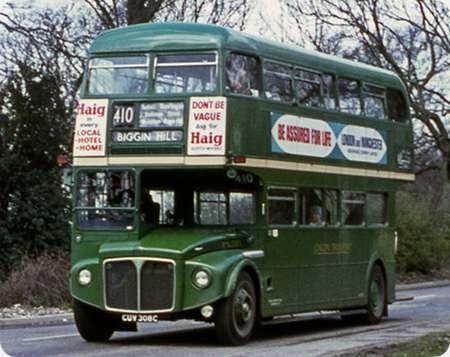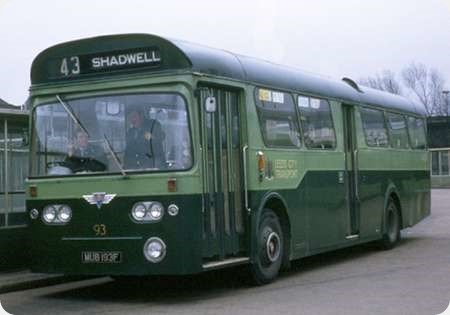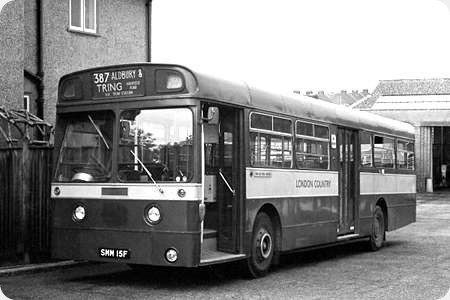London Transport – AEC Routemaster – CUV 308C – RML 2308
London Transport
1965
AEC Routemaster
Park Royal H40/32R
OBP seems yet to have a picture of Routemasters in the Country Area livery, so here is one. RML 2308, delivered to London Transport in November 1965, is seen at Biggin Hill in the following year. These green buses, which totalled one hundred in two batches of fifty, RML 2306- 2355 in 1965 and RML 2411 -2460 in 1966, were all powered by the AEC AV590 engine de-rated to 115bhp, the same setting used in the earlier RT type, though the RML was 5cwt heavier. Semi automatic gearboxes were fitted rather than the fully automatic variety used in the Central Bus Routemaster fleet. The 410 ran between Bromley and Reigate on an hourly headway, with intervening ‘short’ journeys between Bromley and Biggin Hill; the picture above shows RML 2308 operating such a ‘short’. Because of a low railway bridge near Oxted station, the 410 route was run for many years by lowbridge double deckers, notably by the ‘Godstone’ STLs ((Godstone being the operating garage) and then by the RLH class (20 diverted Regent IIIs from a Midland General order for 30, and a further 56 built for LT). In the early 1960s LT(CB&C) yearned to standardise the Godstone fleet on RTs, and became impatient about the delays to the promised lowering of the roadway beneath the Oxted bridge. I was then a clerk in the South Divisional Office at Reigate, and pointed out that the offending bridge could be circumnavigated easily via Station Road East, then under the high bridge on the A25, and back into Oxted via East Hill Road. This solution was eagerly leapt upon, and RTs replaced the Godstone RLH fleet in November 1964. This allowed full interworking of the routes 409 (West Croydon – Godstone – Forest Row) 410 (Bromley – Godstone – Reigate) and 411 West Croydon – Godstone – Reigate). When the roadway under the Oxted Station bridge was ultimately lowered some time later, the 410 reverted to its original route. The LT Country Bus business passed to the National Bus Company in January 1970 under the name London Country. In 1978, with Routemaster mechanical spares becoming akin to hens teeth, and London Transport snapping up such parts as did become available, the entire London Country RML fleet was sold to LT, who repainted most of the vehicles red for service in London, though RMLs 2306, 2337, 2417, 2420, 2421, 2423, 2424, 2425, 2426, 2427, 2433, 2436, 2438, 2448, 2449, 2458 and 2459 were immediately scrapped for spares. In the early 1990s LT replaced all the original power plants in the survivors with Iveco and Cummins engines, RM 2308 suffering the inflicted indignity of a Cummins motor in 1993. It continued to serve London Transport until its withdrawal in March 2004.
Photograph and Copy contributed by Roger Cox
02/12/19 – 06:37
In actual fact, the Central London RM’s and RML’s had an either/or gearbox.
If top gear was selected when stationary, the bus would be in automatic mode, however, the driver had the option of driving them as a semi auto, and changing gear manually.
Unless fully loaded, or pulling away uphill, second was usually selected to pull away.
It may well be that in later life they were all converted to fully auto, but they weren’t when new.
Ronnie Hoye
02/12/19 – 09:46
The Central Bus Routemasters had fully automatic gearboxes with manual over-ride, a feature of auto boxes that continued into the later age of buses with auto transmissions by ZF and Allison, though not with the (dreadful) three speed Voith. Nowadays it seems that this feature has gone for buses, and the driver’s only over-ride option is kick-down. The Country area RMCs, RMLs and RCLs were semi auto only.
Roger Cox
03/12/19 – 06:30
I don’t know if its the way they’re set up, but some buses are awful. They seem to snatch when they change up, and lurch when changing down. The poor driver always gets the blame, but in reality there’s not a lot He/She can do about it.
Driver properly, a bus with a manual box, be it three pedals or semi auto, will always give a smoother ride than an automatic.
Ronnie Hoye
03/12/19 – 06:32
I had the pleasure, until recently, when prevented by ill health, of being a regular driver of RML 2440 a refurbished and re-engined bus – owned by Peter Cartwright. This most definitely was of the Fully automatic type. The coaches were semi-auto only – RMC and RCL.
David Oldfield
03/12/19 – 09:15
RML 2440 was sold by LCBS to London Transport in June 1979. It then went into Aldenham for conversion to LT specifications, including the addition of full auto operation of the gearbox before entering service as a red bus. In ‘Country’ service it was semi auto only.
Roger Cox
06/12/19 – 06:51
Your suggestion, Roger, about avoiding the low bridge at Oxted, which presumably was not greatly disadvantageous to passengers, is typical of a situation whereby nobody thinks of a solution for decades and it’s staring them in the face!
It certainly seems odd to my eyes in seeing a bus routed for 410 which is not lowbridge. I’m sure I’ve said before that the unique lowbridge STL’s (always with their sliding doors open, to avoid being illegal) would appear from time to time at Morden to cover overhauls of the lowbridge red D’s on the 127 and latterly lowbridge Tilling Bristol K’s, sometimes green and sometimes red!
With the ex-Romford Green Line D’s coming to Merton Garage, which took a while to repaint them into red, pre-war RT’s on the 93 and Maidstone Corporation Daimler CWG6’s, Morden Station’s Forecourt was was a real hotchpotch of colour, types and companies. Wonderful!
Chris Hebbron
08/12/19 – 06:18
There is a lot of truth in what Chris says, especially in large organisations. People become blinkered, because things have always been done in a certain way. A new employee with fresh set of eyes can often reveal new ways of doing things, that no one has previously thought of. It’s all a bit like the Hans Christian Aderson’s "The King’s New Suit of Clothes". Send for Danny Kaye!
Mr Anon
09/12/19 – 06:25
Ah, Danny Kaye. I always recall "The Court Jester" – The constant muddling up of "The pellet with the poison’s in the vessel with the pestle; the chalice from the palace has the brew that is true!" Classic!
Chris Hebbron
09/12/19 – 12:20
Chris, if memory serves the quote from Danny Kaye went something like,
"The flagon with the dragon is the chalice with the malice, the vessel with the pestle is the brew that is true". How do I remember that?
Stan Zapiec
09/12/19 – 16:27
Here is the script gents
//www.irossco.com/comedy/poem10.htm
https://www.youtube.com/watch?v=WzmnSyqv37A
John Lomas
13/12/19 – 12:17
Wonderful stuff. Dedicated to everyone, who has been to the shops on behalf of their partner, then come back with completely the wrong thing.
Mr Anon
Quick links to the - Comments Page - Contact Page - Home Page



